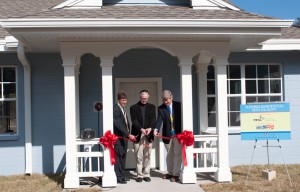COCOA, Jan. 14, 2011 – Recognizing the need for statewide energy efficiency, UCF’s Florida Solar Energy Center celebrates the completion of its newest research facility for testing energy improvements in new and existing homes. A ribbon-cutting ceremony for this endeavor was held today on UCF’s Cocoa campus.
Initial research at the Flexible Residential Test Facility will focus on energy improvement potentials in vintage Florida homes. Those constructed prior to 1975 make up 63 percent of Florida’s more than eight million existing homes, which represents a substantial energy and cost savings potential for cost-effective, “deep” home energy improvements, or retrofits. Prospective savings could result in 30 to 50 percent of current residential energy use.
Funded by the state’s Florida Energy Systems Consortium, the research facility was instrumental in attracting a major multi-million dollar, four-year research grant from the U.S. Department of Energy (DOE).

“As we address greenhouse gas emissions, we have to look at retrofitting existing homes. This facility will be instrumental in researching the impacts of home energy efficiency improvements in hot climates,” said Mr. David Lee, U.S. Department of Energy’s Director of Residential Building Programs.
The facility consists of two side-by-side homes that will assist researchers in evaluating a large variety of both envelope and systems improvements. The homes will be heavily instrumented, and occupancy effects will be simulated by scheduled computer-controlled heat and moisture generation and appliance use. Monitored results from these experiments will test and verify computer simulation models now in widespread use for existing and new home energy efficiency evaluation.
For more information about this new research facility, contact Robin Vieira, Buildings Research Director at robin@fsec.ucf.edu or 321-638-1404.
FSEC – Creating Energy Independence: The Florida Solar Energy Center (FSEC), a research institute of the University of Central Florida, is the largest and most active state-supported energy research institute in the nation. Current divisions and their research activities include Advanced Energy Research: alternative transportation systems, hydrogen fuel and fuel cells; Buildings Research: energy-efficient buildings; and Solar Energy: solar water and pool heating and solar electric and distributed generation systems. For more information about the center, visit http://www.floridaenergycenter.org or call the FSEC Public Affairs Office at 321-638-1015.
UCF Stands For Opportunity: The University of Central Florida is a metropolitan research university that ranks as the 2nd largest in the nation with more than 56,000 students. UCF’s first classes were offered in 1968. The university offers impressive academic and research environments that power the region’s economic development. UCF’s culture of opportunity is driven by our diversity, Orlando environment, history of entrepreneurship and our youth, relevance and energy. For more information, visit http://news.ucf.edu.
PR11-01
Hi, I’m curious if you can post any news about this project from a couple of years back:
——-
These folks at UCF.EDU back in 2008 wrote about and built a “cool white roof” intentionally to collect moisture from inside the house.
We got the same effect reroofing our 1920s house with a cool white roof, but it took us by surprise, we didn’t know it would happen — so we’re looking for info on building the smart computer controlled ventilation system described in the excerpt below.
So far I haven’t found any help. I’d really like to get details enough to build it.
This is from 2008 and describes the problem as an opportunity, being tested:
http://fsec.ucf.edu/en/publications/pdf/FSEC-CR-1771-08.pdf
——excerpt follows—–
…. with no way for the moisture to be removed from the building there is only a temporary benefit from adding the desiccant packs unless the attic is ventilated.
Therefore four watt DC ventilation fans were added to the otherwise sealed NightCool attic – one for supply ventilation feeding in 40 cfm (19 L/s) of outside air from the south east side soffit and the other exhausting warm moist air from the attic western side ridge and exhausting that air out of the north soffit.
In January 2008 we began controlling the experimental facility attic ventilation based on the difference in the attic to outdoor absolute humidity. In this mode of operation, the sun’s heat warms the attic and dries the desiccants activating the attic ventilation fans and thereby removing moisture. The status of the fans is determined every five minutes. If the exterior humidity is lower than that inside, the ventilation fans are activated. Otherwise they remain unpowered. During the night the ventilation ends and the desiccant reabsorbs moisture from the space during NightCool operation….”
Mr. Roberts:
According to Danny Parker, author of the publication you refer to, in order to do what you want to do (drying the attic with sealed attic construction) you would need a special controller, which is not on the market.
Essentially, at the Nightcool facility, we ventilate the attic when the attic dew point is higher than the outdoor dew point. (Can’t use relative humidity; must use dewpoint). We use a datalogger to make the decision to vent or not vent the attic every five minutes.
* If attic dewpoint is > outdoor dewpoint, then turn on vent fan
* Otherwise don’t vent
This could be done with two reliable hygrometers (we use Vaisala humidity transmitters) and with a microcontroller and a D.C. powered attic vent fan.
It doesn’t exist, but it could exist and someone with electronics skills could accomplish this.